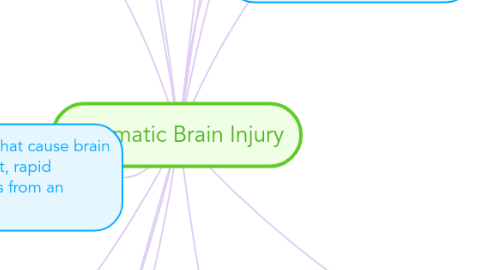
1. Blast injury is a signature injury of the US military
1.1. There are 2 mechanisms by which a primary blast injury occurs
1.1.1. direct transcranial blast wave propagation
1.1.2. the transfer of kinetic energy from the blast wave through the vasculature, which triggers pressure oscillations in the blood vessels leading to the brain
1.1.3. Elevations in CSF or venous pressure caused by compression of the thorax and abdomen and by propagation of a shock wave through the bv's or CSF
1.2. Can result in edema, contusion, DAI hematoma, and hemorrhage
1.3. A wide spectrum of injury severities may occur ranging from mild or blast concussion to severe and fatal
2. Definition: and alteration in brain function, or other evidence of brain pathology, caused by an external force
3. People under 25 and people over 65 are at the greatest risk for TBI
3.1. Hospitalization and death is most common older adults with TBI
3.2. TBIs are most common in children ages 0-4
4. Brain damage results from external forces that cause brain tissue to make direct contact with an object, rapid acceleration or deceleration, or blast waves from an explosion
4.1. Brain tissue damage can be categorized as either primary injury that is due to direct trauma to the parenchyma or secondary injury that results from a cascade of biochemical, cellular, and molecular events that evolve over time due to the initial injury and injury related hypoxia, edema, and elevated ICP
4.2. Contact injuries often result in contusions, lacerations, and intracerebral hematomas
4.3. Common areas of focal injury are the anterior temporal poles, frontal poles, lateral and inferior temporal cortices, and orbital frontal cortices
4.4. Acceleration and deceleration cause shear, tensile, and compression forces within the brain, which causes diffuse axonal injury, tissue tearing, and intracerebral hemorrhages
4.5. Diffuse axonal injury is the predominant MOI in most individuals with severe to moderate TBI
4.6. DAI most often occurs in discrete areas: the presagittal white matter of the cerebral cortex, the corpus callous, and the pontine-mesencephalic junction adjacent to the superior cerebellar peduncles
4.7. Since the mechanism of DAI is microscopic, there are minimal initial findings on MRI and CT.
4.8. Acceleration/ deceleration forces cause disruption of neurofilaments within the axon leading to Wallerian type axonal degeneration
5. Causes of TBI in order of prevalence: Falls, MVA,struck by/against, assaults
6. Symptoms of dysautonomia:
6.1. Increased sympathetic activity results in increased heart rate, respiratory rate, and blood pressure, diaphoresis, and hyperthermia
6.2. Decerebrate and decorticate posturing, hypertonia, and teeth grinding
7. Secondary impairments of TBI:
7.1. DVT
7.2. Heterotopic Ossification
7.3. Pressure ulcer
7.4. Pneumonia
7.5. Chronic pain
7.6. Contractures
7.7. Decreased endurance
7.8. Muscle atrophy
7.9. Fracture
7.10. Peripheral nerve damage
8. TBI severity is measured by the Glascow Coma Scale
8.1. Mild
8.2. Moderate
8.3. Severe
9. Leading cause of injury related death and disability in the US
10. Secondary cell death occurs as a result of a chain of cellular events that follow tissue damage in addition to the secondary effects of hypoxemia, hypotension, ischemia, edema, and elevated ICP
10.1. Normal ICP is 5 to 20 cm H20
10.2. Primary and secondary MOIs are not mutually exclusive and often do not occur in isolation
11. The cognitive and behavioral changes associated with TBI are often more disabling than the physical effects
11.1. The impairments commonly associated with TBI include those in the categories of:
11.1.1. Neuromuscular
11.1.1.1. Paresis
11.1.1.2. Abnormal tone
11.1.1.3. Motor function
11.1.1.4. Postural control
11.1.2. Cognitive
11.1.2.1. Arousal level
11.1.2.2. Attention
11.1.2.3. Concentration
11.1.2.4. Memory
11.1.2.5. Learning
11.1.2.6. Executive functions
11.1.3. Neurobehavioral
11.1.3.1. Agitation/aggression
11.1.3.2. Disinhibition
11.1.3.3. Apathy
11.1.3.4. Emotional lability
11.1.3.5. Mental inflexibility
11.1.3.6. Impulsivity
11.1.3.7. Irritability
11.1.4. Communication
11.1.5. Swallowing
12. Many cognitive functions are controlled in the frontal lobes
12.1. Because of this, people with TBI are particularly susceptible to cognitive impairments
13. Executive functions can be categorized into:
13.1. Planning
13.2. Cognitive flexibility
13.3. Initiation and self-generation
13.4. Response inhibition
13.5. Serial ordering
13.6. Sequencing
14. Altered levels of consciousness
14.1. Coma
14.1.1. Arousal system not functioning
14.1.2. No sleep/wake cycles
14.1.3. Ventilatory dependent
14.1.4. Usually not permanent
14.2. Vegetative state
14.2.1. There is dissociation between wakefulness and awareness
14.2.2. Brainstem is able to manage basic cardiac, respiratory and other vegetative functions and the patient can be weaned off the ventilator
14.2.3. Sleep/wake cycles are present
14.2.4. Awareness of surroundings is absent
14.2.5. A withdraw response to noxious stimuli is present
14.3. Minimally conscious state
14.3.1. There is minimal evidence of self or environmental awareness
14.3.2. Cognitively mediated behaviors occur inconsistently
14.3.3. Sleep/wake cycles are present
14.3.4. Localize to noxious stimuli
14.3.5. May inconsistently reach for objects
14.3.6. May localize to sound location
14.3.7. May demonstrate sustained visual fixation and visual pursuit
15. Due to the wide variety of cognitive, motor, and neurobehavioral impairments that accompany brain injury, it can be difficult to establish goals and predict progress
15.1. Low initial scores on the GCS, particularly motor score and pupillary reactivity, have been identified as a predictor of poor recovery in patients with moderate to severe TBI
15.2. Age, race lower education level are also poor predictors
15.3. Petechial hemorrhages, subarachnoid bleeds, obliteration of the 3rd ventricle of basal cisterns, midline shift, and subdural hematoma finding on initial CT scan are also poor predictors
15.4. Duration of post traumatic amnesia is another important indicator
15.4.1. Length of time between the injury and the time at which the patient is able to consistently remember ongoing events
15.4.2. PTA < 48.5 days are more likely to have a higher FIM score at d/c from inpatient rehab
15.4.3. <27 days likely to be employed
15.4.4. <34 days good overall recovery
15.4.5. < 53 days likely to be living without A
